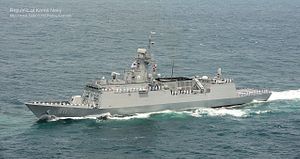The Republic of Korea Navy (RoKN) has reportedly launched its sixth Incheon-class Future Frigate Experimental (FFX) guided-missile frigate, according to Yonhap News Agency.
The newest addition to South Korea’s Navy has been named Gwangju and was launched on August 11 in Changwon, home to Seoul’s major naval facilities including the country’s Naval Academy. It is scheduled to be handed over to the navy in early 2016 and should be commissioned by the end of the same year.
According to IHS Jane’s Defense Weekly, the Gwangju is the third vessel built by STX Offshore & Shipbuilding – the world’s fourth largest shipbuilder – and follows two ships launched in August and October 2014, respectively. The first three ships of the class were built by Hyundai Heavy Industries. The first Incheon-class frigate, the Incheon, was launched in April 2011 and commissioned in January 2013.
The new ship is a multi-role frigate and can fulfill a host of different tasks including coastal patrols, anti-submarine warfare, as well as anti-air warfare. IHS Jane’s Defense Weekly elaborates on the Incheon-class technical specification in detail:
The Incheon-class vessels are fitted with a 127 mm gun as the primary weapon, along with one six-barrelled Phalanx Block 1B close-in weapon system (CIWS) for defense against incoming threats.
For submarine prosecution, the platforms are equipped with hull-mounted and towed array sonar systems and with six (two triple) 324 mm torpedo tubes that can deploy the indigenously developed K745 Cheong Sangeo (Blue Shark) torpedoes.
Powered by a Combined Diesel or Gas (CODOG) propulsion arrangement, Incheon-class ships have a top speed of 30 kt and a standard range of 4,500 n miles at 13 kt. They can each accommodate 140 crew and the flight deck can also embark one AgustaWestland AW159 Wildcat helicopter.
Seoul plans to build a total of 20 Incheon-class guided missile frigates by 2020, gradually replacing the aging Pohang-class corvettes and Ulsan-class frigates. Specifically discussing the Gwangju, Yonhap paraphrased a statement made by the South Korean navy noting that “[o]nce deployed, it [the Gwangju] will be tasked with patrolling and defending South Korea’s sea territory and contribute as deterrence against North Korea’s aggression.”
However, as I reported before (See: “Will Corruption Undermine South Korea’s Sub Modernization Program?”), corruption has rattled South Korea’s naval modernization program undermining public confidence in the country’s naval buildup. For example, the navy’s former Chief of Naval Operations (CNO), Admiral Hwang Ki-chul, has been indicted for manipulating documents during the evaluation process of a ship’s performance so that a foreign supplier, favored by Hwang, could win the bidding contract. In addition, the former head of the navy, CNO Chung Ok-geun, has also been arrested on charges of taking bribes.

































